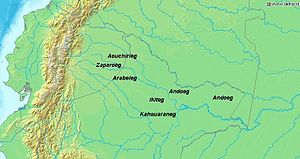- Arabela language
-
"Arabela" redirects here. For the television series, see Arabela (TV series).
Arabela Tapweyokwaka Spoken in  Peru
PeruNative speakers 50 (2002 SIL)[1] (date missing) Language family Zaparoan- Arabela–Andoa
- Arabela
Official status Regulated by No official regulation Language codes ISO 639-3 arl 
This page contains IPA phonetic symbols in Unicode. Without proper rendering support, you may see question marks, boxes, or other symbols instead of Unicode characters. Arabela is an indigenous American language of the Zaparoan family spoken in two Peruvian villages in tropical forest along the Napo tributary of the Arabela river.
Also known as Chiripuno and Chiripunu, it is spoken by about 50 people out of an ethnic population of about 500[1]
Since there are so few speakers of Arabela left, its speakers speak either Spanish or Quechua as a second language. The literacy rate for Arabela as a first language is about 10–30%, and about 50–75% for a second language. It uses a SVO word order,[1] just as the majority of the world's languages.
Like all native languages in Peru, it has an official status in areas where it is spoken.[2]
Contents
The language and its speakers
Arabela is a language of the Zaparoan family of languages. Zaparoan tongues were once widely spoken in the rain forest of north-eastern Peru, but Zaparoan-speaking people have been decimated by diseases, wars with neighboring native groups, and by quasi-enslavement during the rubber boom. Most Zaparoan communities have shifted to Lamas Quechua or Spanish, while others have been incorporated into Shuar groups. The few surviving Zaparoan languages are all severely endangered. Among those, Arabela is most closely related to Zaparo (the only one still spoken), Andoa and Conambo.
Current situation
The dominant languages of the area are Kichwa and Spanish, and they are both widely spoken by Arabelas. Kichwa has been the default language for native communities in the area since the rubber boom era, and has spread through trade mixed marriages. It is, however, losing ground to Spanish in the younger generations. The use of Arabela is restricted to a small elderly fraction of the population. The language is official per the Constitution of Peru, but this did not stop its decline. There is no written literature in Arabela, but the language has been used in education by the Peruvian government, which has issued some school material in it. The Universal Declaration of Human Rights has been translated into Arabela in 1988.[3]
Dialectal divisions
There is no dialectal division among known Arabela speakers. A small group, called Pananuyuri, separated from other Arabelas roughly a century ago. Their fate is unknown but they may have survived, in which case their dialect is likely to have somewhat diverged from the other speakers'.[citation needed]
Phonology
The Arabela phonemic inventory is quite typical for a Zaparoan language. It has five places of articulation and a vowel inventory of five vowels common within the family.[citation needed]
Vowels
Vowels Front Near-front Back Close i ɪ u Near-close o Open a Consonants
Consonants Bilabial Dental /
AlveolarPostalveolar Velar Glottal Stop [p] [t] [k] Fricative [s] [ʃ] [ɦ] Nasal [m] [n] Approximant [w] [j] Trill [r] Morphology
The noun
Arabela has no grammatical gender but for a few words, mostly describing persons, the sex can be specified by adding a suffix :
- Cua niya-nu : my son
- Cua niya-tu : my daughter
Arabela has two grammatical numbers, singular and plural. The plural is generally added by adding a suffix to the singular, the nature of this suffix varying according the pluralized word.
- tia : house yields tiaca : houses
- maaji : woman, yields maajipohua : women
- niyacoo : unmarried girl yields niyacoojori : unmarried girls.
In a few cases, however, the plural can be formed through suffix substitution, or by using a different root altogether.
- caya : man yields canuu
- maanu : group yields maapue
- nucua : mother yields nuhuocuaca
A numbers of other word form their plural by removing a singular specific suffix
- saijia stone yields sai stone
Pronouns
Arabela has a complex pronominal system, similar to the one of the other zaparoan languages and distinguishes between active and passive personal pronouns. Active pronouns act as subjects in independent clause and as objects in dependent ones.
Personal pronouns
Personal pronouns First singular Second singular Third singular First plural inclusive First plural exclusive Second plural Third plural Independent clause subject janiya
-nijiyaquiajaniya
quiaa
-quiaanojuajua
-Vripaa
-pue
paajaniyacanaa niajaniya
niaanojori Independent clause object cua quia na
quiniopa canaa nia nojori
na
-noAnaphoric pronouns
The verbal ending -no is used as an anaphoric. It can also mark the subject of a subordinate sentence when it refers to the object of the main sentence.
Demonstrative pronouns
Arabela has three kinds of demonstrative pronouns :
- noo indicates an object close to the speaker
- nio indicates an object further away from the speaker (Nio-te quia panishano - is it what you want)
- cuno indicates a contrast between objects or persons (cuno-cuaja cua sare - this is my dog)
Interrogative pronouns
Arabela has a rather restricted of interrogative pronouns, composed of:
- cana : who
- canapue : who (plural)
- casaa : what
- taa : how, how much
- taamueca : how
- tee : where
- teje : where from
- teyano : who, which
References
- ^ a b c Arabela language at Ethnologue
- ^ a b "CONSTITUCION POLÍTICA DEL PERÚ 1993". February 17, 2006. http://pdba.georgetown.edu/Constitutions/Peru/per93reforms05.html. Retrieved 2009-03-02. Artículo 48º Son idiomas oficiales el castellano y, en las zonas donde predominen, también lo son el quechua, el aimara y las demás lenguas aborígenes, según la ley.
- ^ The Universal Declaration of Human Rights in Arabela
Bibliography
- Dicconario Arabella—Castellano, Rolland G. Rich, Instituto Lingüistico de Verano, Perú – 1999
- Rich, Furne. 1963. "Arabela Phonemes and High-Level Phonology," SPIL I, 193-206
External links
Categories:- Language articles with undated speaker data
- Languages of Peru
- Zaparoan languages
- Arabela–Andoa
Wikimedia Foundation. 2010.
